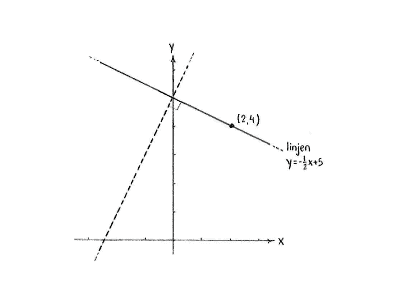Solution 2.2:5d
From Förberedande kurs i matematik 1
(Difference between revisions)
m (Robot: Automated text replacement (-[[Bild: +[[Image:)) |
m |
||
| (2 intermediate revisions not shown.) | |||
| Line 1: | Line 1: | ||
| - | {{ | + | If two non-vertical lines are perpendicular to each other, their slopes <math>k_{1}</math> and <math>k_{2}</math> satisfy the relation <math>k_{1}k_{2}=-1</math>, and from this we have that the line we are looking for must have a slope that is given by |
| - | < | + | |
| - | {{ | + | {{Displayed math||<math>k_{2} = -\frac{1}{k_{1}} = -\frac{1}{2}</math>}} |
| - | {{ | + | |
| - | <center> [[Image:2_2_5d-2(2).gif]] </center> | + | since the line <math>y=2x+5</math> has a slope <math>k_{1}=2</math> |
| - | + | (the coefficient in front of ''x''). | |
| - | + | ||
| + | The line we are looking for can thus be written in the form | ||
| + | |||
| + | {{Displayed math||<math>y=-\frac{1}{2}x+m</math>}} | ||
| + | |||
| + | with ''m'' as an unknown constant. | ||
| + | |||
| + | Because the point (2,4) should lie on the line, (2,4) must satisfy the equation of the line, | ||
| + | |||
| + | {{Displayed math||<math>4=-\frac{1}{2}\cdot 2+m\,,</math>}} | ||
| + | |||
| + | i.e. <math>m=5</math>. The equation of the line is <math>y=-\frac{1}{2}x+5</math>. | ||
| + | |||
| + | |||
| + | <center>[[Image:2_2_5d-2(2).gif]]</center> | ||
Current revision
If two non-vertical lines are perpendicular to each other, their slopes \displaystyle k_{1} and \displaystyle k_{2} satisfy the relation \displaystyle k_{1}k_{2}=-1, and from this we have that the line we are looking for must have a slope that is given by
| \displaystyle k_{2} = -\frac{1}{k_{1}} = -\frac{1}{2} |
since the line \displaystyle y=2x+5 has a slope \displaystyle k_{1}=2 (the coefficient in front of x).
The line we are looking for can thus be written in the form
| \displaystyle y=-\frac{1}{2}x+m |
with m as an unknown constant.
Because the point (2,4) should lie on the line, (2,4) must satisfy the equation of the line,
| \displaystyle 4=-\frac{1}{2}\cdot 2+m\,, |
i.e. \displaystyle m=5. The equation of the line is \displaystyle y=-\frac{1}{2}x+5.

